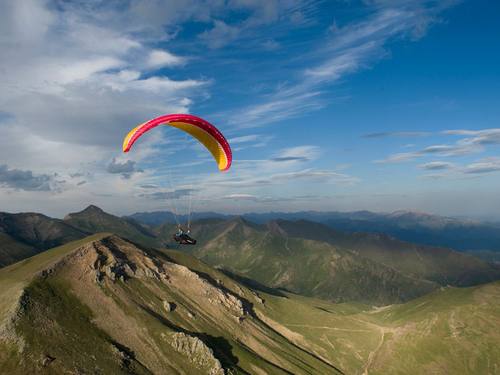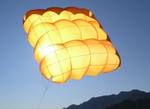Gradient Nevada BHPA "Skywings" January 2013 Review/Flight test Gradient Nevada By Ian Grayland
55 cells. Aspect ratio five point seven. Only 230 metres of line. At first glance Gradient's
latest wing is clearly pitched right at the top of the EN B slot.
Construction
Wing fabric is the well-tried and tested 409 Porcher
Skytex with a 459 leading edge strip for extra
durability The 56 cells are grouped in threes for
most of the span using partial diagonal cell walls
for support. Blocks of four in the centre section and
the middle of the inboard Line groups use Gradient's
unique 'Double Diagonal' bracing. This gives a slight
reduction in line attachment count for the total
number of cells, or - more importantly - more cells
for your line-set and less line drag.. This layout also
makes the central part of the wing a bit bigger in
relation to the ears, which with only two main A
lines per side are still relatively large.
Leading edge reinforcement consists of trilam
Mylar sheet with nylon rod stiffeners sewn in about
an inch away from the wing surface. B [line loads are
spread chord-wise using small arches of nylon rod
over the attachment points, whist the remaining
attachments are conventional. Lines are a well
thought out mix of Vectran and Dyneema,
progressively sized across the span and chord to
minimise Line drag and maintain good Length
stability over time.
The three slim risers, plus a split A, join the [lines via
neat stainless steel maillons with durable plastic
inserts. Riser lengths are scaled pro rata with
glider size, keeping things comfortable for smaller
pilots. Brake keepers are large and functional Dot
fasteners; there's even a couple of these to attach
the two risers together when you pack away. The
accelerator uses a 3:1 pulley system on the As with
a linear B riser travel, until about half bar when the
Bs lock to the As, de-cambering the wing
progressively for the remainder of the travel.
Packing Trials
The rucksack is smart, well made, durable[e and nice
to carry, but the XL size is too short for a full size
pod harness and all your kit. Be sure to ask for an
XXL unless you have a compact harness.
In common with a good many wings these days the
recommended packing method for the Nevada is
concertina folding. Also in common with a good
many manufacturers these days, the wing is
supplied with a conventional nylon inner bag, totally
unsuited to this purpose. I ended up bunging the
wing in a mushroom bag and carrying it around
separately - and my harness and helmet still didn't
fit in the rucksack!
On the ground
I lay it out ready for launch. Yikes! Where are all the
lines? I look baffled for a moment at the split A
risers before my first inflation. With only one line on
each A riser rt took a moment or two to decide
which ones to pull. In the event, it turned out just
about any of them would do.
Ground handling is impeccable; effortless both
mentally and physically, The wing is easy to hold
overhead even in a strongish wind, with very little
tendency to cravat during abusive ground handling. I
take the split As for the range of inflation options
they provide as well as dedicated big ears control. I
also like the clean simplicity, obvious functionality
and ease of use of three risers.
For routine reverse launches I mostly used just the
inner A risers, allowing the tips to follow and inflate
fully with the wing overhead. Collapsing the wing on
windy top landings was simplified with the quickly
accessible C risers. They're so easy to f find you don't
need to look for them.
Handling
0n the crucial first take-off my impression was
of a fast trim speed with an immediately
reassuring feet. The brakes felt a gnat's short at
first, then soon bedded in after a few minutes
use. Brake travel is long and pressure is
pleasantly tight and progressive. Agility is
excellent with very good response on turn entry,
exit and quick reversals. Weight shift and brakes
are nicety harmonised, with the wing feeling well
sorted in terms of trimming. in fact, it feels
exactly like a top end EN B.
I was immediately able to turn very tightly and
efficiently in the small thermal cores of an
Autumn Easterly on my first flight. This is a very
good climber. Once high, the Nevada has the glide
performance to stay there, and the speed and
stability to cut into wind to get to the next climb.
Considering the relatively high Level of agility, you
get a fairy easy ride in rough air. The Nevada is a
little 'busier' in rough air than, for example, a
couple of the UPs I have been flying lately, but it
is very easy to keep open in heavy turbulence. The
wing has quite a 'wide' feel and responds wet[ to
a wide setting on the chest strap, producing lots
of feedback through the harness from we[[
outboard - very good for sniffing out turn
direction in weak lift or picking the best line while
penetrating into wind with little or no brake.
Min sink is quite close to trim speed with glide
degrading steeply as you slow. it is generally best
to keep the Nevada 'on the boil'whilst
thermalling unless you are in a good solid core.
This wing is at its best in gusty broken lift rather
than the weak, wimpy stuff.
lmporter's comment
Thanks to Ian for the review. Ian's expertise as a
pilot and hang/paragider designer surely informs
his opinion and it's great that the Nevada has
satisfied his scrutiny. Nevada offers a really
practical[ EN B as well as giving toads of useful
performance. Ian's praise is supported by other
web and magazine reviews, and f lights of over
200km with the Nevada. My feeling from my tests
in the UK and France indicate Nevada will be a
cracking XC glider for the new season and
beyond. And if you want a Gradient concertina bag
with your new Nevada, just ask.
Brad Nicholas Snowdon Gliders
That said, on the fourth outing, this time in
relatively gentle thermic Lift [2 - 300 fpm], I was
left with an even more positive view. Quite
simply, wow! Launching very late in one weak
cycle I had to climb through the whole pack.
Despite the more bizarre flying antics of some of
the crowd around me I was able effortlessly to
crank my way up the inside and top out with the
early starters. This kind of performance /
handling balance on an EN B glider is very rare.
Performance
Glide performance is nothing short of excellent.
The Nevada penetrates wet[ into headwinds
and climbs very well in gusty headwind
conditions. it has a very flat glide on the speed
bar and good stability at speed. There is no
'kick down' so the bar has longish travel
despite the shortish pulley movement. I was
easily able to get the pulleys touching on the
top rung of the ladder bar, but I would modify
this if it was my own glider to shorten the leg
movement required [you guessed, I have
short legs].
Trim speed is nearly 40km/h, at the fast end of
things for the leisure class. Half bar takes this
up to about 50 with very good and increasing
stability as you apply more bar. The outboard
regions of the wing are noticeably particularity
solid. Pulley to pulley the Nevada holds a
respectable 53km/h or more, still with a
usefully flat glide. I’m in cold thick winter air
here and my feeling is that these numbers
don't really do the wing justice; this glider will
outrun a good many EN Cs.
Stability
I gave the ears a bit more attention than I normally
would for a review. 0n a glider with only two A lines
per side there is a lot of wing carried on the outer A
line. This results in very big ears and I was keen to
establish that the wing was stable with the ears in -
especially with a good boot fut of speed bar applied. I
can assure you it is completely stable with or
without speed bar and despite my best efforts to
destabilize things. Putt in the ears with the
dedicated split A riser, one at a time, both at once,
with or without speed bar, any which way you [like...
and down you come, stable and fast. Just what the
doctor ordered.
Spiral stability is excellent, with a strong pro-spiral
input required both to initiate and to hold it in.
Easing off, the wing immediately starts to recover
important for wings in the leisure class with our
steadily ageing pilot population.
Pitching off trim speed in either direction
followed by a quick release results in a rapid
return to trim with little overshoot or hunting.
This, in combination with very good rot[ damping,
results in a relatively steady flight through rough
air. Some recent wings in this class tend to get
'rolled about' quite a bit and occasionally even
rolled out of lift - not so the Nevada.
Weight range
The Nevada 26was a very good f it for me at 95 -
97kg all. up using Sky's Excite 3 comp harness. Sink
rate is very good, so don't be worried about [loading
it up if you're a bit heavier.
Summary
This wing is very well matched to the top end B
market sector. it responds well to being flown
accurately in turns and at optimum speeds, but is
also tolerant of sloppy piloting. I found the Nevada
fun and rewarding to fly, and the cause of much
interest amongst local pilots.
The Nevada will suit pilots moving down from C class
or higher Looking for sporty, responsive handling with
the security of an EN B certificate Experienced EN B
pilots might choose the Nevada over its rivals for its
sporty handling, fast trim and flat glide. Pilots moving
up should find no difficulty managing the upgrade.
Performance-wise, at time of writing its only rear
direct competitors are not yet in production.
+++ Sporty feet with EN B safety.
+++ Performance and fun. Easy handing.
--- No concertina bag.
- Shop
- Training
- Brands
- About Us
-
Welcome to our Store!
Axis paragliding is the registered Partnership of Stephen Millson and Catherine Betts. Axis was first registered in 1997, and was trading under another company name (trekking Uk Ltd) since 1992.

-
- Customer Service
-
Shipping
FREE UK SHIPPING OVER £100 VALUE We will attempt to ship your order within 4 days and will normally send your order to you in 2 business days. If you require your order urgently, please call to confirm, we will do our best to supply as quickly as possible.
Shop with Confidence
All goods remain the property of Axis Paragliding until paid for in full.
-
- Information
- Contact Us




